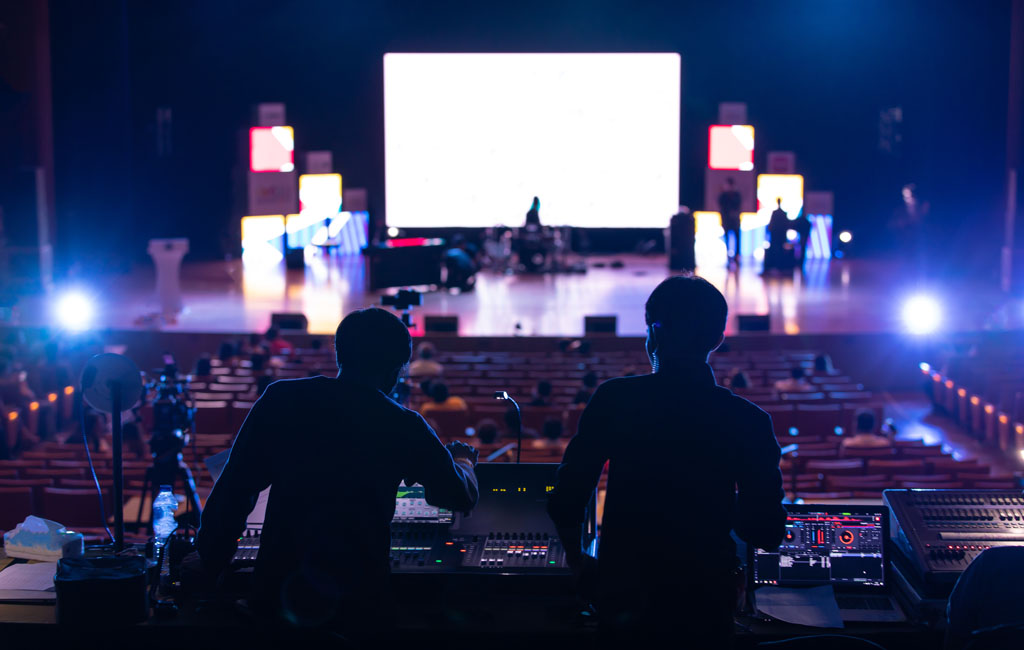LISTEN HERE
21 Oct 2025
A WEEK IN THE LIFE

Subscribe to CX E-News
When you mix a band live, what, in your opinion, has the most significant impact on the overall mix? Is it your skill with reverb settings, a mastery of compression release times, an ear for EQ, or what? For me it’s all about confidence, and that only comes from preparation. Here’s how I usually go about it…
The first thing I always do when I’m mixing a band live on stage is establish good, early communications so as to be thoroughly prepared for the upcoming gig. Being prepared for a live gig is the best foundation any great mix can ever hope for. The ultimate aim here is to provide yourself with enough gig-specific accurate information, and ample time, to set up the show in a stress-free, relaxed manner. The aim for the band is the same: you want them happy, relaxed and brimming with confidence in you.
This might initially take the form of a phone call to the venue operator, band manager, or individual musicians a week or so before the show to establish early contact. Here you might politely ask for a stage plan and input list for the show you’ll be mixing. This will often illicit a generic email response at first, containing a stage plan that’s scarcely relevant to the show in question, but that’s all okay because now you’ve got a week to rectify this discrepancy, not four hours!
Once it has been established in a friendly return email or phone call that, “The stage plan for the show is possibly not reflected accurately in the file you’ve sent,” often a newer plan will then emerge that’s specific to the gig. This is the point where the email thread – if that’s how you’re communicating – can get quite specific, and it’s also one of the best ways to contain all the information for the show in one place. As you might surmise from this last comment, I always take my laptop to shows, and one of the first things I do when I arrive at Front of House is open the email thread and read it again.
Closer to the show – the day before, typically – it pays to clarify one last time that everything is still on track for the gig, and that nothing has changed either in terms of the stage plan or band lineup. By then, of course, it’s likely something has. Despite your best efforts, most communication and change happens late in proceedings… it’s just the nature of the beast. Changes might include an additional band member, a different band combination, a bunch of extra DIs for a keyboard player, an illness… who knows.
Regardless of what it is, it pays dividends to remain friendly and flexible about any ‘last-minute’ adjustments to a stage plan the band might suggest. Accommodating these shifts right up to the soundcheck deadline is important to establishing a relaxed and friendly working environment. Of course, this inevitably involves having your phone fully charged on the day of the gig too, in anticipation that someone will always be trying to get in contact with you. Don’t leave your phone on a desk somewhere and discover three hours later that you’ve missed 14 phone calls from the band.
It’s not always possible to accommodate change, of course, but whenever it is, the answer should always be ‘yes’ to any specific band requests. That said, in my experience the more prepared you’ve been in the week leading up to a show, the less surprises you’re likely to encounter last-minute.
Gig Day Prep
On the day of a gig I like to arrive well before the band, in some cases several hours earlier. Depending on how complex the setup is, the more time I afford myself. I hate being short on time nearly as much as I do being ill-prepared.
Actually, I think being time-poor is possibly the worst gig preparation anyone can gift themselves. It nearly always sets up a chain of events that can lead to mistakes, drama and generally heightened stress levels for everyone involved. Avoiding this at all costs is vitally important to the outcome of the show.
My ideal timeframe on gig day is that, an hour or so before the band is due to arrive I will have already tuned the PA, fully wired the stage to reflect the latest plan, setup the console in a way that suits my workflow, had time to fiddle with some reverbs, listened to all the wedges on stage, and set up the house music. In short, everything works at this point, functioning according to the plan.
With about an hour to the band’s predicted ETA – and this is specific to my current role at Archies Creek (formerly the Caravan Club), which is about 90 minutes away for most musicians travelling from Melbourne – I like to give someone in the band who I’ve already been in communication with a quick call, to firstly put them at ease by letting them know that we’re setup and ready for their arrival, but also to establish a more accurate ETA. This allows the band to relax, knowing that they’re in safe (professional) hands. Otherwise, the long drive can sometimes provide musicians with time enough to wind themselves up into a stressed frame of mind. It also gives me a clearer picture of who’s arriving when, and therefore how I might try and run the soundcheck.
This phone call also gives me time to react in advance to any changes to the stage layout and input list that haven’t been previously discussed.
“Oh, we’ve just found out that Fred is bringing his other synth, so we’re gonna need another stereo DI line, and maybe even a keyboard stand if you have one there.”
My response to these sorts of requests is always, “Yeah, sure, no problem.”
And the reason it’s no problem is simple: I’m setup – have been for a while now – and I’m therefore free to do nothing but make changes at this point, if that’s what’s required. I am not starting from scratch with no spare time. I’m not stressed, the band isn’t either, and the changes are usually pretty trivial anyway.
If, by the time the band arrives, all they then have to really do is plug in, make some noise and demand a few levels of the various instruments, by soundcheck’s end everyone will be remarking about how easy that was, and their confidence in you and the venue will have grown exponentially.
This is the best preparation you can give yourself for a great mix.
On The Flipside
The one downside of this sort of ‘well-oiled’ preparation is that sometimes you establish such a relaxed atmosphere that it can quickly tip over into a ‘party atmosphere’. This mightn’t sound so bad on the surface, but occasionally when musicians hit the stage simultaneously, chatting quickly becomes jamming and the result can often be chaos. Pulling back from this to establish a more formal soundcheck timeline can then be quite tricky. Once they start, it’s hard to get musicians to stop!
The important thing to remember at this point is that, while it’s nice that everyone’s feeling relaxed and accommodated, the important incomplete task remains sound-checking the individual instruments, to make sure you’re happy with what you’re hearing at Front of House. Sometimes you can get rushed by the band at this point, so it’s pays to maintain polite control over proceedings. Things shouldn’t take too long from here, so you can point that out politely to the band too – “We just need to soundcheck you folks one at a time now, if that’s okay – which shouldn’t take long because we’re all setup.”
For any instruments that remain problematic in some way, you now have the time and headspace to resolve them.
Before The Doors
Once soundcheck is over and the band has cleared off backstage to eat, get changed or drink lemonade, it pays to pop in on them to check that they’re all good for the show. You don’t have to go around officiously asking a million questions. Sometimes all you have to do is be visible in the space. They may need something from you, or request something that they previously forgot to mention in soundcheck.
Once these requests have been gathered in my head, I like to pop back to Front of House and guesstimate these changes at the console. After that I like to sit at the board a bit longer and go through all the channels to make sure everything is as it should be: EQs, compressors and gates armed (or switched off) where necessary, foldback sends perused to make sure nothing that’s clearly in error has found its way into a send – hey, it happens – and FX sends are being fed by only those things I intended – maybe a main vocal, a snare…
At this point I like to unmute everything and once again push the PA up in level to see if anything takes off. If it does, I can make the requisite adjustments before the doors open. After that, there is to be no more feedback – ever!
I also like to peruse the FX parameters at this point, fine-tuning filter points and reverb times etc. All of these parameters inevitably change during a show of course, but I like to cast an eye over them anyway. It’s kind of like my meditation pre-show, allowing me time to relax. It also provides another opportunity for me to spot a mistake while things are relatively quiet, or for my brain to remember something I’ve overlooked.
Once I’m happy and confident, I save two backups of the show, and now I’m all set.
Mixing is now the easy part!
—
Andy Stewart owns and operates The Mill on Victoria’s Bass Coast. He’s a highly credentialed producer/engineer who’s seen it all in studios for over four decades. He’s happy to respond to any pleas for recording or mixing help… contact him at: andy@themill.net.au
Subscribe
Published monthly since 1991, our famous AV industry magazine is free for download or pay for print. Subscribers also receive CX News, our free weekly email with the latest industry news and jobs.






